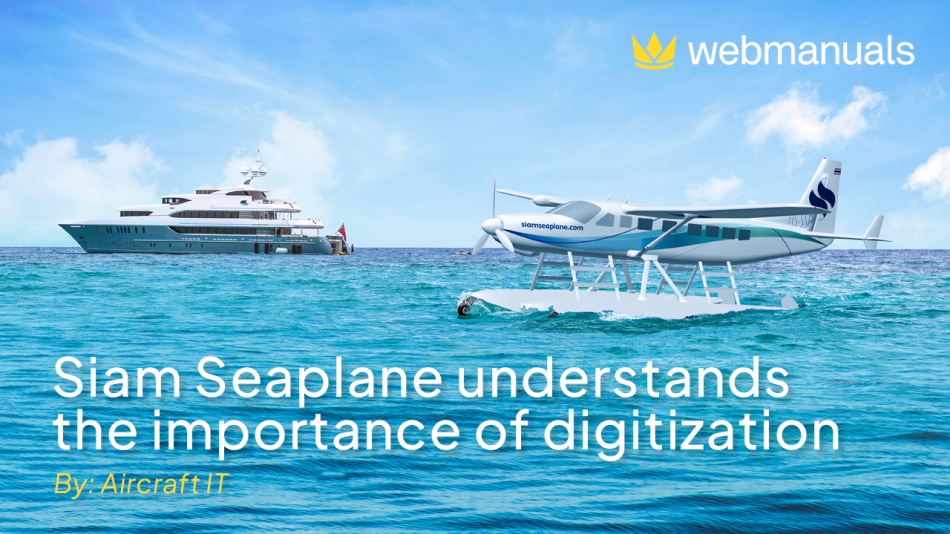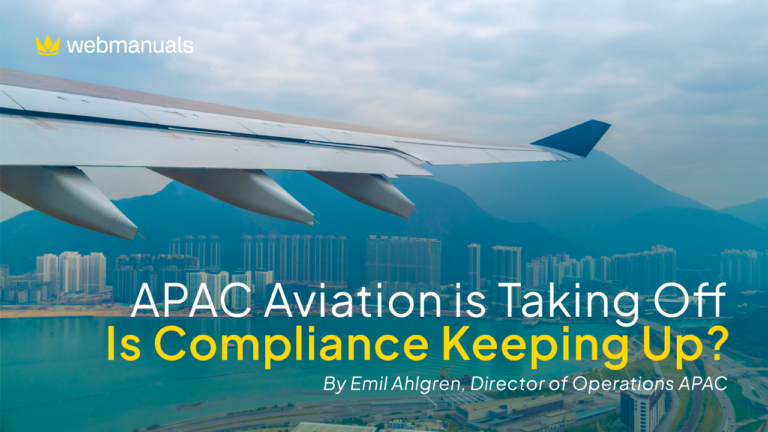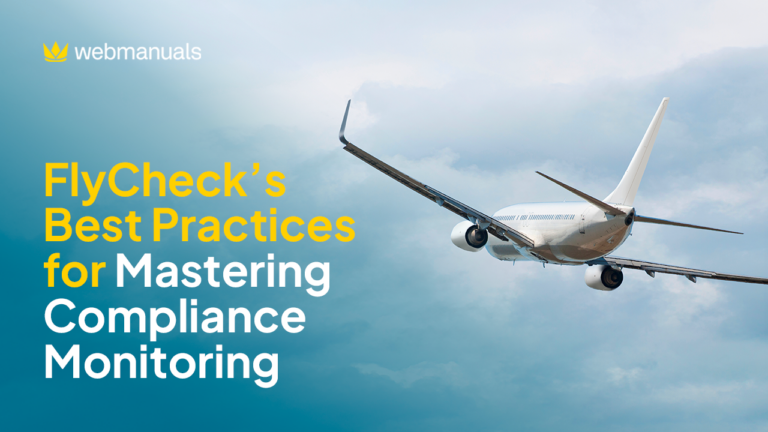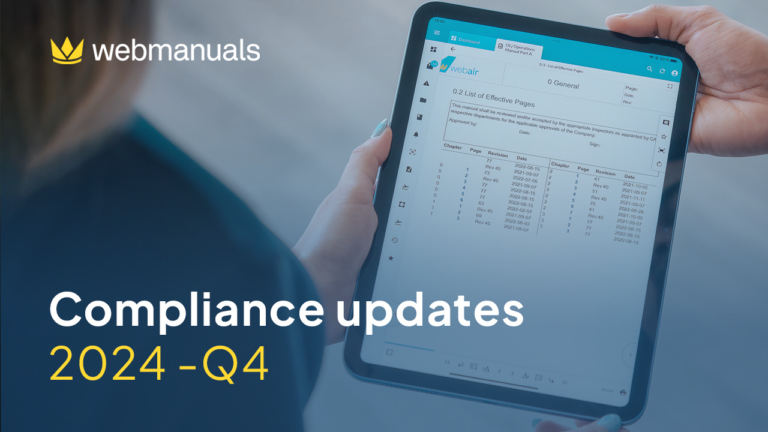Author: Dennis Keller, Chief Business Officer, Siam Seaplane and Emil Ahlgren, Director of Operations, Web Manuals. Published in Aircraft IT.
The plan is for this case study to take readers through Siam Seaplane’s adoption of a digital document solution and the importance of digitization for the airline including, what it means to start up an entirely new operation and what are important considerations for a business starting from scratch.
There were a number of factors that Siam Seaplane looked at initially when thinking about the service that they planned to build. First, people want something different now and Siam Seaplane sits at the intersection between aviation and hospitality. People don’t just want a nicer hotel room; they want experiences, memories, something to take home with them. Everything needs to be accessible at your fingertips and this is where digitization comes in for the customer as well as for the back office. These days a mobile first and digital first is a must; there is no other way of running a service. But there are a few other important things to note in terms of a changing world.
Readers will be painfully aware of COVID, but post-COVID, people now want different things, it’s a different world. They want more hygienic transportation, they want safer services and, importantly, they just want to travel; everybody just wants to get out there again to experience something new, something different. This is where Siam Seaplane comes in. Finally, and uniquely, because it is quite difficult to reach some of the waterfront destinations in Thailand, that was a key motivation for Siam Seaplane to provide seaplane services. It sounds quite easy in theory but, in practice, it has been quite a ride for the new airline with the team working on it for the past three years from right before COVID, a great time to start a new airline; however, today, Siam Seaplane is getting ready to start services.
Siam Seaplane
As the name suggests, this airline is a seaplane operator providing premium amphibious seaplane services as well as scenic flights and ground-to-ground charters with a Cessna Caravan aircraft. The business is being built with a much bigger lifestyle umbrella in mind and it’s being built digital first. The target is the premium mass market up to the luxury market; not a low-cost or mass market service, not competing with existing airlines but more of a ‘last-mile’ transportation service as a complementary transportation experience to bring people to their ultimate destination.
In terms of the customer journey (figure 1), Siam Seaplane believes that there is a lot more to it than just the flight. Typically, when thinking of customer journeys, there are some things that have to be considered from check-in to the waiting, the boarding, take-off, the flight and the landing – items in pink on the list.

But when the team started to design this airline, they realized that there’s a lot more to the customer journey. It starts way before the stages already mentioned with discovery, when people have their first thoughts about what do they want to do and what that will require; and it goes all the way through until the very end in terms of loyalty, memories and customer retention. Then, there is the back-end operation which is very important because it empowers and enables the customer. Without the back-end operation it’s not possible to do anything. It ranges from regulatory set-up when the airline started to obtaining the AOC (Aircraft Operator’s Certificate), right the way through to the day-to-day operations on flight management, flight following, communications and so on.
With the need to provide great customer journeys, it is necessary to be digitally native. That means that systems and solutions for the airline’s customers should be easy-to-use personalized apps; everything end-to-end needs to be smooth and to be seamless. Siam Seaplane relies a lot on its partners but the key is that dealing with the airline and the journey needs to be as easy as possible. So, if someone, let’s say, doesn’t go to one of the airline’s hotel partners to book the journey, they might want to go to Siam Seaplane. Then, if the airline didn’t have its own app, if it didn’t have its own interfaces, that would make it difficult for the customer and that is not what is wanted.
The cutting-edge technology and digital solutions are incredibly important for the airline and were the focus on day one of building the company as opposed to just as an afterthought. There is, of course, one great example of this that Siam Seaplane found and that was Web Manuals which played a pivotal role on the operational set-up of the company, AOC preparation and, looking ahead, compliance.
The document project
With that, let’s have a look at what the project looked like and what it has entailed. As we’ve already said, what better time to start an airline than during a pandemic! But Siam Seaplane did and successfully. In June 2020, in the middle of the pandemic, the decision was made for the airline to adopt Web Manuals and go digital with the documentation right from the start. The teams from Web Manuals and Siam Seaplane worked well together because, unlike some who might have become used to working with paper-based systems, the airline team were mentally prepared to be digital. Yet, it was still very different from what Web Manuals had seen before. Rather than the sort of big corporation or smaller operator with which Web Manuals often works, this was a unique type of operation which was interesting, exciting.
For the implementation of Web Manuals and the document project, the Siam Seaplane team were very committed and self-taught. Of course, Web manuals was there to provide support and deliver the training but because the airline had been digital from the start, the whole implementation was made much easier. As well as the documentation itself, there was the support for regulations, working closely with CAAT (Civil Aviation Authority of Thailand) and other organizations and authorities to come up with details preparing for the kind of operation that was envisaged and already looking to the future.
One of the reasons why the project and launch were so successful is because Siam Seaplane wanted to be agile and have the documentation available and, again, during the pandemic, people were not travelling but working remotely from home. That made it all the more important for the new airline to have one place for all of the documents and to be able to continue even from different remote places.
What was important for Siam Seaplane right from the beginning as well as during the pandemic was that there was a team that was already dispersed in different places so there wasn’t one office where everybody needed to be present every day. When the company was started, one of the first considerations was to ask, what are the right digital solutions so that, in general, from a work management perspective, everything could be digital and, from a compliance audit perspective, from a control perspective, the airline should have the right tools that would support that. Initially, they were looking at using one of the commonly used document editing softwares to make the manuals and support the AOC. It seemed that that would be sufficient with audit trail function, collaborative function but it was quickly realized that would be far from what was required by the regulator and others.
Web Manuals offered exactly what was needed including the capability to work from anywhere, to work virtually and still everything in place that was needed. That helped the airline with a lot for things that are less crucial in terms of audit trail. Coming again to the regulatory perspective, as a next step in the collaboration between Siam Seaplane and Web Manuals, that regulatory aspect, required the implementation all of the regulations in the business and for the Web Manuals system to be able to create compliance linking, and automated compliance reports and checklists out of the system. So, as the airline had already been working closely with the regulators, this will be the next step together.
What is unique to Siam Seaplane is that, in terms of the regulatory compliance, the airline is not only looking at CAAT but a number of other regulators so still needs a certain creative approach to how they are bringing together the various stakeholders and information management for handling the audit process for something between twelve to 15 authorities for the water landing sites. The authorities include the Marine Department, a few departments in the Environment Ministry, the local regulators, in some cases the navy and, in some cases, the police. The challenge was how to keep track of that without having an office filled with paperwork.
A digitally enabled customer journey
We also want to give readers a few examples of what that digitally enabled customer journey looks like (figure 2) for guests, for customers. We’ll look at the digital activity around the customer journey and the partner integration.

This is starting with the discovery phase when people are searching for what to do (figure 3).

Here it’s important to say that Siam Seaplane is working closely with a lot of luxury resorts where the airline is in their booking systems but not everybody starts looking there. So, if they just Google, say, ‘how to fly on a seaplane in Thailand’ they might come directly to Siam Seaplane. It’s important to make sure that the airline’s App is there, that the App works and is tied in to the partner offerings. In the next phase, we’re talking about transportation not for the actual flight but how to get to the airport.

For example, there might be a flight from Bangkok to Jomtien, as in figure 4. It’s a real example that customers could book but still somebody needs to go to the airport to get on the aircraft so why not collaborate with a ground transportation service to make the whole journey seamless? It’s a good example of digital innovation to make it as easy as possible for guests to make the journey.
When it comes to check in, the example in figure 5 is about form factors.

Again, the notion is to make it as seamless as possible; for instance, to check in with a QR code on your phone or check in with an NFC wristband or similar form factors.
Looking at take-off and flight (figure 6), Siam Seaplane aims for and assumes that everybody will enjoy the scenery and Thailand is a beautiful country to fly above, there are so many nice islands and coastal areas, mountains and so on; but maybe not everybody will want to see the scenery.
For instance, children might not care about looking out of the window and so it’s important to be able to provide the right in-flight entertainment such as an iPad with personalized services available. Here again, taking a bit of an innovative approach might mean having data on what is the marine life and ecology below where the aircraft is flying: this makes it a little more entertaining and interesting to engage with the surroundings.
The important thing with water landing (figure 6) is things such as the integration with partners like the hotel to notify them that, in ten or 15 minutes, the plane will be landing so that they can get ready for the guests to arrive, for the check-in with everything seamlessly connected.

Similarly, disembarkation and passage to the hotel (figure 7) should be an entirely seamless experience for the guest handled through the App so that they don’t have to go up to the desk with all of their documentation but that can all be handled through either the Siam Seaplane App or the Hotel App.

Getting started
At the time of writing, landing sites were being finalized and the first aircraft had been delivered. The airline was starting with its sister brand, Siam Scenic to offer ground-to-ground charters and scenic flights. The aircraft is a Cessna Caravan, VIP configured for up to eight people. With that end-to-end mindset, the service needs to be seamless, comfortable; in short, it needs to be an experience.
All that said, pricing is very accessible at around $300 per flight hour per person or, for charter, around $2,000 per flight hour. So not limited to the VIP or private jet experience.
Conclusions
In everything, guests come first. This has been Siam Seaplane’s approach from the start: what are customers looking for, how can their lives be made easy and what needs to be put in place to achieve that. The means that the airline needs to invest, to ask, to listen which will take time but will be worth it. The airline also needs to be able to integrate partners with immediate provision for the right APIs, the right kind of platforms to ensure that there is compatibility with other systems. Siam Seaplane cannot do this on its own which is why the partnership with Web Manuals and other partners is so important.
Siam Seaplane has been built from scratch which can often be a real benefit instead of building onto legacy. This has been the airline’s approach with their own App and, to an extent, with their own booking system. It isn’t just about the flight but it is important to go wider and think about the whole lifestyle and the whole experience around what guests want to see.
It’s very important to invest in competence and this doesn’t just mean buzzwords or hiring one or two digital managers; there has to be investment in competence and significant commitment to push through with digital solutions and to understand them. And finally, don’t over-complicate, which is certainly true for a premium service like Siam Seaplane that needs to be about simplicity for the people out there and needs to be seamless. Intelligent simplicity is what wins; to ensure that Siam Seaplane can deliver a service that people really want.




